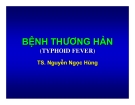
Typhoid fever
-
Thương hàn là chứng bệnh đường tiêu hóa do nhiễm vi trùng Salmonella enterica serovar Typhi. Bệnh hiểm nghèo này lây lan khi vi trùng trong phân người bị bệnh nhiễm vào thức ăn hay thức uống và truyền sang người khác.[1] Khi theo thức ăn vào ruột, vi trùng xuyên vào thành ruột và bị thực bào bởi đại thực bào. Salmonella typhi lúc đó thay đổi cấu trúc của nó để chống lại sự phá hủy và cho phép chúng tồn tại bên trong đại thực bào. Điều này giúp chúng chống lại sự gây hại của bạch...
 30p
30p  drngheo
drngheo
 29-09-2010
29-09-2010
 307
307
 50
50
 Download
Download
CHỦ ĐỀ BẠN MUỐN TÌM













